Gone (but not forgotten?)
While some science fiction imagines humanity alone in the universe, other stories imagine that life just like our own is plentiful outside our Solar System. One common thread in such stories is the idea of precursor civilisations - ancient races that lived, died and passed out of general knowledge long before humanity took to the stars.
Mysterious Forerunners
Some of the most common and compelling ancient races in science fiction are those which are deeply mysterious at the start of a story, and often remain so right until the end. These are the races that pass out of all knowledge and are forgotten - or at best pass into myth and legend - before rediscovery of their relics by humanity and other younger races. Inevitably, the revelations of their nature or impact often form the focus or finale of stories, and so it’s hard to avoid spoilers although I’ll do what I can.
An early example of this trope can be found in Murray Leinster’s short story “The Lost Race” (1949, adapted for the radio as an episode of Dimension X in 1950). This tale describes a civilisation that left hundred-millennia-old ruins across hundreds of planets in the Galaxy, but no clue as to why these had been deliberately destroyed:
“Their ruins are found in an area two thousand light-years across. They had metals and alloys - scraps of which have markedly advanced human metallurgy - and they build roads and dug canals and moved earth and stone in incredible masses. They must have mastered space travel, and they must have had arts and possibly music and literature. But above all they had a genius for the destruction of their own edifices, so that all that is left is rubble and dust.”
Stranded as a result of a technical breakdown, far off the space lanes, and ravaged by intra-crew conflicts, one human spaceship stumbles across a section of ancient city that has survived the destruction, for the first time getting a hint of what might have led the Lost Race to commit racial suicide. The story explores a number of topics including the practicalities of interstellar travel and the effect it might have on human psyches. Indeed, Murray Leinster selected this story as his own favourite in the anthology My Best Science Fiction Story (eds. Margulies and Friend, 1949), for the fun he had exploring the issues. However the story’s lingering imagery is of the vast sweeps of destruction and the technology that the stranded crew discovers.
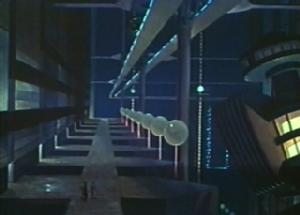 Similarly mysterious ancient races whose own actions ultimately led to their disappearance abound in science fiction. The Jokers in Terry Pratchett’s early science fiction novel The Dark Side of the Sun (1976) left enigmatic structures in the form of vastly tall and technologically-advanced towers scattered across worlds in space. The only clue to their fate is the puzzling statement that they could be found on the dark side of the Sun. Similarly, the alien builders of megastructures such as the Dyson sphere known as Orbitsville (novel, 1975, Bob Shaw) and of Larry Niven’s eponymous Ringworld (novel, 1970) must be powerful races that remain unknown and potentially unknowable. The long-vanished Krell in Forbidden Planet (Film, 1956, dir. Wilcox) appear to have been equally powerful, albeit with traces only known from one planet. Their disappearance resulted from an experiment undertaken at the height of their powers, the nature of which only gradually becomes clear as the film progresses.
Similarly mysterious ancient races whose own actions ultimately led to their disappearance abound in science fiction. The Jokers in Terry Pratchett’s early science fiction novel The Dark Side of the Sun (1976) left enigmatic structures in the form of vastly tall and technologically-advanced towers scattered across worlds in space. The only clue to their fate is the puzzling statement that they could be found on the dark side of the Sun. Similarly, the alien builders of megastructures such as the Dyson sphere known as Orbitsville (novel, 1975, Bob Shaw) and of Larry Niven’s eponymous Ringworld (novel, 1970) must be powerful races that remain unknown and potentially unknowable. The long-vanished Krell in Forbidden Planet (Film, 1956, dir. Wilcox) appear to have been equally powerful, albeit with traces only known from one planet. Their disappearance resulted from an experiment undertaken at the height of their powers, the nature of which only gradually becomes clear as the film progresses.
Echoes of the Krell can be found in ancient civilisations elsewhere, for example in the First Ones, a group of races described in Babylon 5 (TV, 1994-1998) as having fought a terrible war in the distant past. While a few of these races ultimately prove not to have left known space or even to be hiding in plain sight, most others have passed beyond the Galactic Rim long before the series started, leaving behind ruins and relics, including a Great Machine discovered on Epsilon III (Babylon 5’s nearest planet) that visually references the Krell City-Machine of Forbidden Planet and the sense of wonder it evoked.
Of course, like the Shadows in Babylon 5, not every ancient race is friendly. And some are likely best left undiscovered. The Engineers in Prometheus (film, 2012, dir. Scott), the creators of the Inhibitors in Revelation Space (novel, 2002, Reynolds) and the Firstborn in Sunstorm (novel, 2005, Clarke & Baxter) are all ancient races which might well have been better left undisturbed by humanity.
The Peril of the Past
While many alien ruins in SF are simply enigmatic riddles, lingering to fascinate and inspire younger races, others present a far more tempting but more perilous prospect: the chance to retro-engineer advanced technologies.
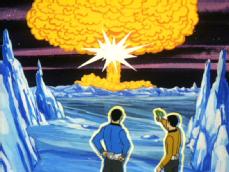 Star Trek: the Animated Series touched on this in 1973 in the episode “The Slaver Weapon”, written by Larry Niven. The premise of this story was adapted from one of Niven’s Known Space short stories ("The Soft Weapon", 1969) and involved Niven’s frequently-used aliens, the Kzin. The Kzinti pirates encountered here steal a rare stasis box (in which time does not elapse) left behind by an ancient civilisation, which had been destroyed a billion years ago as a result of a rebellion by one of its subject races. As we’re told by Mr Spock: “The Slavers and all their subjects were exterminated in the war that followed. Intelligent life had to evolve all over again. The stasis boxes are the only remnant of those lost civilisations.”
Star Trek: the Animated Series touched on this in 1973 in the episode “The Slaver Weapon”, written by Larry Niven. The premise of this story was adapted from one of Niven’s Known Space short stories ("The Soft Weapon", 1969) and involved Niven’s frequently-used aliens, the Kzin. The Kzinti pirates encountered here steal a rare stasis box (in which time does not elapse) left behind by an ancient civilisation, which had been destroyed a billion years ago as a result of a rebellion by one of its subject races. As we’re told by Mr Spock: “The Slavers and all their subjects were exterminated in the war that followed. Intelligent life had to evolve all over again. The stasis boxes are the only remnant of those lost civilisations.”
The script makes it clear that these boxes have enhanced Federation technology, but also that opening one is a highly unpredictable and dangerous endeavour. In both the short story and the episode adaptation, misuse of the weapon found within the box has catastrophic consequences.
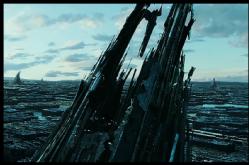 In Andre Norton’s Forerunners series of novels, starting with Forerunner Foray in 1973, the ruins of an ancient civilisation have been found on a variety of planets. These are explored for technological remnants, archeological artefacts or even trinkets that can be sold on - either openly or through a thriving black market. The details of this race, and of the long-post-Earth human society, remain rather vague, but are somewhat clarified in the sequel novels Forerunner (1981) and Forerunner: the Second Venture (1985). These introduce a character who proves to be a reborn member of the ancient race and receptive to lingering memories of her earlier existence.
In Andre Norton’s Forerunners series of novels, starting with Forerunner Foray in 1973, the ruins of an ancient civilisation have been found on a variety of planets. These are explored for technological remnants, archeological artefacts or even trinkets that can be sold on - either openly or through a thriving black market. The details of this race, and of the long-post-Earth human society, remain rather vague, but are somewhat clarified in the sequel novels Forerunner (1981) and Forerunner: the Second Venture (1985). These introduce a character who proves to be a reborn member of the ancient race and receptive to lingering memories of her earlier existence.
In the more recent series The Expanse (novels, Corey, 2011-; TV, 2015-2022) memories instead linger embedded in technology (a “proto-molecule”) and - as becomes gradually apparent - an artificial intelligence. Awakened after many millions of years, this tries to discover the fate of its creators, activating a range of technology which is not so much inimical to humanity as simply indifferent to the negative impact it has on them.
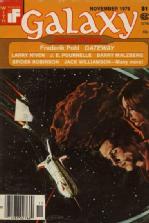 The idea that long-gone aliens might leave behind stores of advanced technology, not just discarded in ruins but buried in deliberate caches, can be found in Frederik Pohl’s Gateway (novel, 1977, originally serialised in Galaxy Science Fiction magazine in 1976). The eponymous settlement, sited inside a hollowed-out asteroid, is itself a relic of the ancient and ambiguous Heechee, and equipped with many preprogrammed spacecraft, each of which has a different destination. At many of these destinations, explorers can find stores of dangerous equipment, set aside in the distant past for unknowable reasons. For most adventurers, the financial bonuses associated with new discoveries outweigh the frequently-lethal consequences of trying to use alien equipment without understanding it.
The idea that long-gone aliens might leave behind stores of advanced technology, not just discarded in ruins but buried in deliberate caches, can be found in Frederik Pohl’s Gateway (novel, 1977, originally serialised in Galaxy Science Fiction magazine in 1976). The eponymous settlement, sited inside a hollowed-out asteroid, is itself a relic of the ancient and ambiguous Heechee, and equipped with many preprogrammed spacecraft, each of which has a different destination. At many of these destinations, explorers can find stores of dangerous equipment, set aside in the distant past for unknowable reasons. For most adventurers, the financial bonuses associated with new discoveries outweigh the frequently-lethal consequences of trying to use alien equipment without understanding it.
The same basic premise can be found in the more recent novel Revenger by Alastair Reynolds (2016) and its two sequels. In these, as in Gateway, spaceship crews risk horrible death or mutilation in pursuit of “baubles” - caches of ancient technology left behind by alien races, and potentially even ancient humans. The remnants of the past even include the partly-cybernetic remains of some aliens, which enable telepathic communication between spacecraft and might have a corrupting influence on minds which come into contact with it.
Each of these stories explores the cost/benefit analysis that lies at the heart of human-type decision making. Both the technical and scientific value of retro-engineering could theoretically be immense, bringing untold benefit in the form of new understanding, techniques and materials. On the other hand, in each of these examples a large part of the value of any artefacts found is simply in their rarity and novelty - a replacement for the precious metals and gemstones of our own times. The question of whether either of these things is worth a cost in sentient lives risked to enable their exploitation is one that will always be challenging to answer.
Ancient Ancestors
In most of the stories mentioned so far, the vanished race is alien and unknowable, with any direct connection to humanity perhaps only hinted at. However another common feature of such vanished-race stories is a rather stronger connection to humanity’s past.
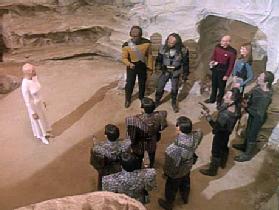 Early viewers of science fiction television series such as Star Trek often questioned why so many of the aliens humans encountered shared the same basic biology - bipedal, bi-lateral symmetry, environmental requirements and even the capacity to interbreed. The honest, if somewhat cynical, answer was that it made them easier to portray on screen by human actors in the years before computer generated imagery. However the in-Universe explanation developed that suggested this was not a coincidence. This was eventually articulated in the sixth series of Star Trek: The Next Generation in the episode “The Chase” (1993). Here Captain Jean-Luc Picard’s archaeology mentor, Professor Galen, solicits his assistance with an expedition to unravel a puzzle encoded in the DNA of the Milky Way’s sentient life. This climax of this story reveals that the evolution of most of the prominent races of the Star Trek universe - including humans, Vulcans (and Romulans), Klingons and Cardassians - resulted from the template left by a single alien race, the Seeders. As an ancient recording reveals:
Early viewers of science fiction television series such as Star Trek often questioned why so many of the aliens humans encountered shared the same basic biology - bipedal, bi-lateral symmetry, environmental requirements and even the capacity to interbreed. The honest, if somewhat cynical, answer was that it made them easier to portray on screen by human actors in the years before computer generated imagery. However the in-Universe explanation developed that suggested this was not a coincidence. This was eventually articulated in the sixth series of Star Trek: The Next Generation in the episode “The Chase” (1993). Here Captain Jean-Luc Picard’s archaeology mentor, Professor Galen, solicits his assistance with an expedition to unravel a puzzle encoded in the DNA of the Milky Way’s sentient life. This climax of this story reveals that the evolution of most of the prominent races of the Star Trek universe - including humans, Vulcans (and Romulans), Klingons and Cardassians - resulted from the template left by a single alien race, the Seeders. As an ancient recording reveals:
“We knew that one day we would be gone, that nothing of us would survive. So, we left you. Our scientists seeded the primordial oceans of many worlds, where life was in its infancy.” … “You are a monument, not to our greatness, but to our existence. That was our wish, that you too would know life, and would keep alive our memory. There is something of us in each of you, and so, something of you in each other."
This premise is known as directed panspermia: the conscious effort to spread the seeds of life. This is as opposed to the usual theory of accidental or undirected panspermia (popularised by cosmologist Fred Hoyle) - the random transport of organic or genetic material between worlds on interstellar dust, comets or other bodies.
Another example of directed panspermia, still more implausible, can be found in the recent film Moonfall (film, 2022, dir. Emmerich). This proposes that Earth’s humans are the result of deliberate planetary seeding by a megastructure-building ancient race that was itself destroyed by its artificially intelligent creations. There are so many scientific problems in this film that this, believe it or not, is by no means the least plausible element.
By contrast, the descent of humanity in the Aliens universe, as described in Prometheus, is less clearly deliberate. Their evolution was triggered by the death of an Engineer which seeded the primordial oceans with microbes and organic material. Similar accidental seeding of life happens elsewhere in speculative fiction - perhaps most bizarrely in the Discworld novel Eric (1990) by Terry Pratchett, in which a half-eaten egg and cress sandwich is responsible for all life on the Disc:
“Thousands of bacteria suddenly found themselves in the midst of a taste explosion, and started to breed like mad. If only there had been some mayonnaise, life might have turned out a whole lot different. More piquant, and perhaps with a little extra cream in it.”
In the Stargate universe (film, 2004, dir. Emmerich; TV franchise, 1994-2011), the vanished race known as the Ancients or Alterans arose in a different galaxy in the distant past. For millions of years, they inhabited a number of planets in the Milky Way, including Earth, being responsible for the city of Atlantis, the Stargate network itself and other similar installations. As in the case of Moonfall and Star Trek, the humans of Stargate appear to have evolved at least in part independently from seed DNA left in the environment by this ancient race. However humans also interbred with stranded and disenchanted Ancients in distant pre-history. Despite this late interbreeding, humanity in Stargate arose mostly independently on an Earth that had long since forgotten the Atlanteans existed, except for the faintest traces of their genes, so that most humans are not direct Ancient descendants and do not have the genetic marker required to operate their technologies. Parallel traces left by the ancients in other galaxies also led to very similar human species to those of Earth.
 While the seeding races of science fiction are mostly long-vanished and either happy to let their descendants evolve in many different directions or remain entirely indifferent, that is not always the case. The Uplift Saga (novels, 1980-1998) by David Brin imagines that all sophonts (intelligent species) result from deliberate genetic and social manipulation by patron races who take on a parental role. Status is determined from the ancestral line of Patrons, and the number of client species a given race has. An exception to this pattern is Earth humanity, who are described as a "Wolfling-race", abandoned in their infancy by their presumed creators. While most of the patron races, and their own earlier patrons, are known, some died out or disappeared, and a huge question remains over the identity and fate of the original Patron race. Artefacts suspected of belonging to those long-gone ancestors of all current species are precious enough to trigger interstellar wars. The lack of a visible patron race gives humanity a special status in these stories and a certain detachment where the ancestral Patrons are concerned.
While the seeding races of science fiction are mostly long-vanished and either happy to let their descendants evolve in many different directions or remain entirely indifferent, that is not always the case. The Uplift Saga (novels, 1980-1998) by David Brin imagines that all sophonts (intelligent species) result from deliberate genetic and social manipulation by patron races who take on a parental role. Status is determined from the ancestral line of Patrons, and the number of client species a given race has. An exception to this pattern is Earth humanity, who are described as a "Wolfling-race", abandoned in their infancy by their presumed creators. While most of the patron races, and their own earlier patrons, are known, some died out or disappeared, and a huge question remains over the identity and fate of the original Patron race. Artefacts suspected of belonging to those long-gone ancestors of all current species are precious enough to trigger interstellar wars. The lack of a visible patron race gives humanity a special status in these stories and a certain detachment where the ancestral Patrons are concerned.
The Old amidst the New
So why are forerunner races so common in science fiction, and what does that say about humanity and our scientific understanding of our own origins?
The idea that humanity was created in its mature state by another long lost species has long been firmly in the territory of fantasy. The evidence for human evolution on Earth has been scientifically strong since the late nineteenth century. The still stronger evidence for a genetic family tree and necessary continuity between humans and all other life here on Earth has been continually reinforced since the mid twentieth. Stories such as "The Lost Race" in which humanity evolved to its current form elsewhere were already something of a throwback to legends of Atlantis and other lost civilisations, or even to older religious beliefs, at the time they were written. However the incorporation of alien DNA into that of Earth’s biosphere at an early stage, as proposed in Stargate, Star Trek and others, would be difficult to confirm or refute - it would simply be the way life is. Indeed, the idea of panspermia - that life might spread between the stars carried as genetic material alone - is a respectable and active scientific field.
It is not, however, without its problems. Some bacteria and even complex organisms, including tardigrades for example, have indeed proved to be able to survive in a dormant state when exposed to vacuum, low temperatures or radiation. However any body (dust grains, interstellar comets or others) small enough to travel between stars, or even between planets and moons in a solar system, lacks an atmosphere and a strong magnetic field. Without those shields, any organic material carried on the body would be exposed to interstellar radiation and cosmic ray bombardment - highly destructive to complex molecules, including DNA. While dormancy, or perhaps burial under rock or ice, might protect some life, the timescales for unpowered travel between the stars are likely of order millions of years. Even known life that can tolerate extreme conditions (extremophiles) is unlikely to be viable after the accumulated damage of so many years travel. As a result, while intra-solar system panspermia might be plausible, interstellar spread of DNA (in the absence of deliberate inoculation of new environments) appears less likely.
Setting aside the issue of our own ancestry then, why do we people space with races more ancient and more advanced than humanity? Well, arguably we could point to the psychological difficulty humanity might experience in facing the unknown. Space is the ultimate frontier, vast in scope and entirely unfamiliar to us. Perhaps we should be unsurprised that we people this unknown either with monsters or with parental and authority figures we can look to for guidance (whether direct or in the form of technological advances). This reflects the same instinct that in the past has populated the skies and oceans with spirits and deities. It suggests that the unknown can be understood and even controlled by sufficiently powerful beings, and hence gives humanity something to aspire to.
There is also a powerful attraction in the idea of finding deep roots in a space that, by its nature, is very new to humanity. Finding ancient ruins would be a reassurance that a planet is (or at least has been) habitable for advanced life and capable of supporting complex civilisations. It would provide a historical foundation - a heritage - that can be referenced or even coopted by human settlers. This could lend an illusion of stability and comfort to those a long way from their own home and heritage.
However, as with directed panspermia, the idea of finding ancient ruins presents scientific difficulties. Not only is reverse engineering a dangerous minefield for those using sledgehammers to crack nuts, but we have to ask whether it's likely that technology, or even building ruins, would survive. Evidence from Earth suggests that an active biosphere is capable of reclaiming and destroying the evidence of civilisation in a matter of decades or centuries, rather than the thousands, millions or even billions of years which are proposed for most forerunner civilisations in science fiction. This is even more true of our modern, technologicallly advanced society than that of our ancestors - much of our material culture is highly ephemeral by design. For buildings, or even machines, to last millions or billions of years would place the materials of which they are constructed into the category of unobtanium - metals or compounds that lie well beyond the understanding of our current materials science.
If life has indeed originated more than once in the Universe (still an unknown), then it has likely originated many times. Given the age of the Universe, the formation history of galaxies and the likely frequency of terrestrial planets around stars, statistical arguments such as Drake's equation tells us that precursor civilisations whose development preceded ours by thousands or even millions of years are likely to be very common in the Universe. Unless civilisations are typically very long lived, many of these will be gone and forgotten long before humanity reaches their home stars. The Milky Way may be full of decaying ruins and abounding in lost technologies.
But whether any evidence of this will survive for us to find, and how we’d react if it did…? That is an area where our current science can offer little insight - and an area where science fiction remains our best arena for thought experiments.
“Gone (but not forgotten?)”, Elizabeth Stanway, Cosmic Stories blog, 18th June 2023
Ideas and opinions expressed here are the author's own, and do not necessarily reflect those of the University of Warwick. All images used are sourced from publicly online archives, and are used here for commentary and criticism.
